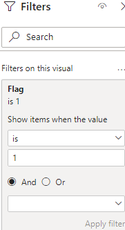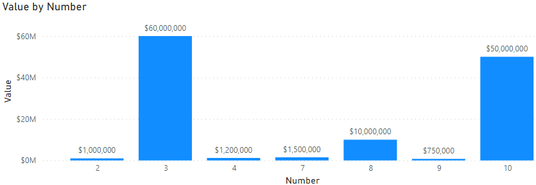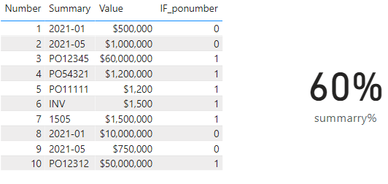Join us at the 2025 Microsoft Fabric Community Conference
Microsoft Fabric Community Conference 2025, March 31 - April 2, Las Vegas, Nevada. Use code FABINSIDER for a $400 discount.
Register now- Power BI forums
- Get Help with Power BI
- Desktop
- Service
- Report Server
- Power Query
- Mobile Apps
- Developer
- DAX Commands and Tips
- Custom Visuals Development Discussion
- Health and Life Sciences
- Power BI Spanish forums
- Translated Spanish Desktop
- Training and Consulting
- Instructor Led Training
- Dashboard in a Day for Women, by Women
- Galleries
- Webinars and Video Gallery
- Data Stories Gallery
- Themes Gallery
- Power BI DataViz World Championships Gallery
- Quick Measures Gallery
- R Script Showcase
- COVID-19 Data Stories Gallery
- Community Connections & How-To Videos
- 2021 MSBizAppsSummit Gallery
- 2020 MSBizAppsSummit Gallery
- 2019 MSBizAppsSummit Gallery
- Events
- Ideas
- Custom Visuals Ideas
- Issues
- Issues
- Events
- Upcoming Events
The Power BI DataViz World Championships are on! With four chances to enter, you could win a spot in the LIVE Grand Finale in Las Vegas. Show off your skills.
- Power BI forums
- Forums
- Get Help with Power BI
- Desktop
- Group numbers
- Subscribe to RSS Feed
- Mark Topic as New
- Mark Topic as Read
- Float this Topic for Current User
- Bookmark
- Subscribe
- Printer Friendly Page
- Mark as New
- Bookmark
- Subscribe
- Mute
- Subscribe to RSS Feed
- Permalink
- Report Inappropriate Content
Group numbers
Hi,
I'm Jerry and new to PowerBI. I'm having some trouble lately to visualize some simple graphs.
I need some simple KPI's or graphs to visualize how many invoices are above the value 50.000. Is this done with a smart measure?
How many invoices are above a certain amount and this in % of total invoices?
How many invoices of the have a po number in the summarry column and this in relation of the total invoices
Example table see below
| Number | Date | Summary | Value |
| 1 | 25/02/2021 | 2021-01 | € 5.000,00 |
| 2 | 22/01/2021 | 2021-05 | € 10.000,00 |
| 3 | 29/01/2021 | PO12345 | € 600.000,00 |
| 4 | 06/09/2021 | PO54321 | € 12.000,00 |
| 5 | 06/09/2021 | PO11111 | € 12,00 |
| 6 | 09/04/2021 | INV | € 15,00 |
| 7 | 11/12/2020 | 1505 | € 15.000,00 |
| 8 | 26/10/2021 | 2021-01 | € 100.000,00 |
| 9 | 13/08/2021 | 2021-05 | € 7.500,00 |
| 10 | 30/06/2021 | PO12312 | € 500.000,00 |
Solved! Go to Solution.
- Mark as New
- Bookmark
- Subscribe
- Mute
- Subscribe to RSS Feed
- Permalink
- Report Inappropriate Content
Hi @jeroend ,
Here are the steps you can follow:
Graphs to visualize how many invoices are above the value 50.000”:
1. Create measure.
Flag =
IF(
MAX('Table'[Value]) >500000,1,0)2. Place [Flag] in Filters, set is=1, apply filter.
3. Result:
Only values greater than 500,000 are displayed
How many invoices are above a certain amount and this in % of total invoices:
1. Create measure.
% of total invoices =
var _over_allcount=COUNTX(FILTER(ALL('Table'),
'Table'[Value]> 500000),[Number])
var _totalinvoices=COUNTX('Table','Table'[Number])
return
DIVIDE(_over_allcount,_totalinvoices)2. Result:
How many invoices of the have a po number in the summarry column and this in relation of the total invoices:
1. Create measure.
IF_ponumber =
var _mid=MID(MAX('Table'[Summary]),5,1)
return
IF(
_mid <> "-",1,0)summarry% =
var _countponumber=COUNTX(FILTER(ALL('Table'),[IF_ponumber]=1),[Number])
var _countall=COUNTX('Table','Table'[Number])
return
DIVIDE(_countponumber,_countall)2. Result.
Best Regards,
Liu Yang
If this post helps, then please consider Accept it as the solution to help the other members find it more quickly
- Mark as New
- Bookmark
- Subscribe
- Mute
- Subscribe to RSS Feed
- Permalink
- Report Inappropriate Content
Hi @jeroend ,
Here are the steps you can follow:
Graphs to visualize how many invoices are above the value 50.000”:
1. Create measure.
Flag =
IF(
MAX('Table'[Value]) >500000,1,0)2. Place [Flag] in Filters, set is=1, apply filter.
3. Result:
Only values greater than 500,000 are displayed
How many invoices are above a certain amount and this in % of total invoices:
1. Create measure.
% of total invoices =
var _over_allcount=COUNTX(FILTER(ALL('Table'),
'Table'[Value]> 500000),[Number])
var _totalinvoices=COUNTX('Table','Table'[Number])
return
DIVIDE(_over_allcount,_totalinvoices)2. Result:
How many invoices of the have a po number in the summarry column and this in relation of the total invoices:
1. Create measure.
IF_ponumber =
var _mid=MID(MAX('Table'[Summary]),5,1)
return
IF(
_mid <> "-",1,0)summarry% =
var _countponumber=COUNTX(FILTER(ALL('Table'),[IF_ponumber]=1),[Number])
var _countall=COUNTX('Table','Table'[Number])
return
DIVIDE(_countponumber,_countall)2. Result.
Best Regards,
Liu Yang
If this post helps, then please consider Accept it as the solution to help the other members find it more quickly
- Mark as New
- Bookmark
- Subscribe
- Mute
- Subscribe to RSS Feed
- Permalink
- Report Inappropriate Content
Measure = CALCULATE(COUNTROWS('Table'),FILTER('Table','Table'[Value]>5000))
Measure 2 = [Measure]/COUNTROWS('Table')
pls see the attachment to check if this is what you want
Did I answer your question? Mark my post as a solution!
Proud to be a Super User!
Helpful resources

Join us at the Microsoft Fabric Community Conference
March 31 - April 2, 2025, in Las Vegas, Nevada. Use code MSCUST for a $150 discount!

Power BI Monthly Update - February 2025
Check out the February 2025 Power BI update to learn about new features.

Join our Community Sticker Challenge 2025
If you love stickers, then you will definitely want to check out our Community Sticker Challenge!

| User | Count |
|---|---|
| 84 | |
| 69 | |
| 68 | |
| 39 | |
| 37 |




